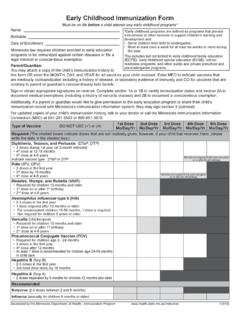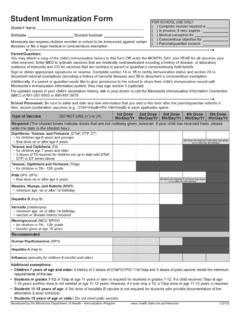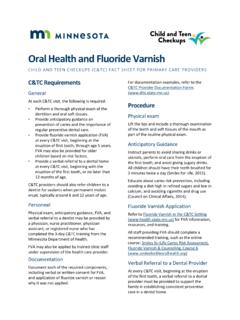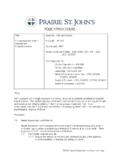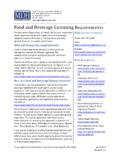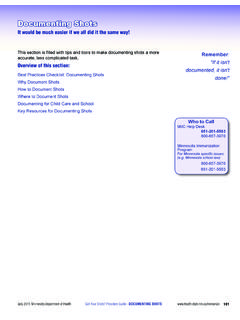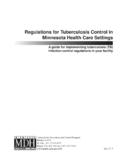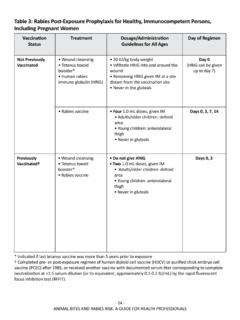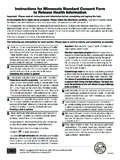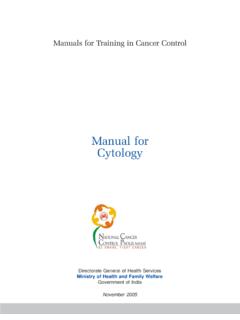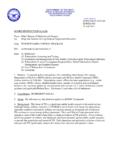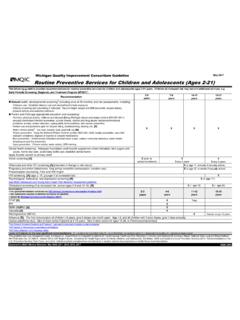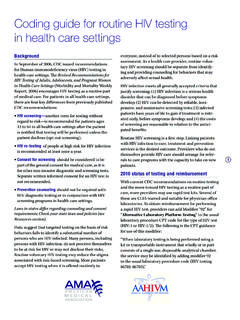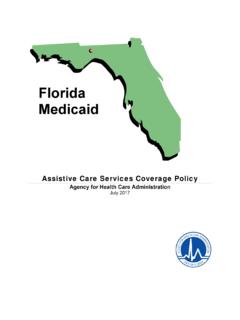Transcription of Vision screening procedures for infancy, childhood …
1 Vision screening procedures for infancy , childhood and School Age Children Minnesota Department of Health (MDH) Community and Family Health Division Maternal and Child Health Section Vision screening procedures for infancy , childhood and School Age Children Revised September 2017 For more information, contact: Minnesota Department of Health Maternal and Child Health Section Child and Adolescent Health Unit PO Box 64882 St. Paul, MN 55164-0882 MDH C&TC website ( ) Contents Background and Overview 5 Purpose and Rationale .. 5 Minnesota s Vision screening Programs .. 5 Pediatric Eye screening or Evaluation 6 Professional Academy 6 Minnesota Department of Health Recommendations.
2 6 Child and Teen Checkups (C&TC) .. 6 Facility .. 7 Equipment .. 7 Vision screening Preparation 10 General Considerations: C&TC Setting .. 10 Preparing For Mass Vision screening .. 11 Rescreening, Referral, Follow-Up, and Program Evaluation .. 14 Vision screening procedures 16 Child and Family Vision History Taking .. 17 External Inspection and Observation .. 19 Binocular Fix and Follow .. 21 Corneal Light Reflex .. 23 Unilateral Cover Test - At Near .. 24 Unilateral Cover Test - At Distance .. 25 Visual Acuity .. 26 Distance Visual Acuity screening - LEA SYMBOLS or HOTV wall charts .. 27 Distance Visual Acuity screening - LEA SYMBOLS /HOTV flip chart .. 30 Distance Visual Acuity screening - Sloan Letters.
3 33 Plus Lens screening .. 35 Color Vision .. 36 Stereo Acuity Test: Random Dot E (Optional) .. 37 Stereo Acuity Test: Stereo Butterfly (Optional) .. 39 procedures for Health Care Personnel 40 Pupillary Light Response .. 41 Retinal (Red Light) Reflex .. 43 Instrument Based Vision screening 44 Overview and Recommendations .. 44 Considerations .. 44 Minnesota Expert Panel on childhood Vision screening 46 Expert Panel .. 46 Minnesota Department of Health Staff 46 Staff Member .. 46 Resources, Glossary, & References 48 Online Vision resources .. 48 Glossary .. 49 References .. 53 Forms, Questionnaires, and Practice Sheets 55 Teacher and Child Vision Pre- screening Worksheet .. 56 Child Vision History Questionnaire for Parent/Caregiver.
4 58 Vision screening Worksheet .. 61 Vision Referral Letter .. 65 Color Vision Advisory Letter .. 67 Child and Teen Checkups Online Resources .. 68 Prescreening LEA SYMBOLS Practice Sheet .. 69 Prescreening HOTV Practice Sheet .. 70 5 Background and Overview Purpose and Rationale Vision screening is a set of procedures performed by properly trained persons for the purpose of early identification of children who may have Vision problems and referral to appropriate medical professionals for further evaluation. The procedures in this manual were developed based on recommendations put forward by a panel of Minnesota-based Vision screening experts who came from a cross-section of screening programs and professional organizations.
5 The Expert Panel on childhood Vision screening was convened by the MDH Community and Family Health Division and met four times between April and June, 2015. The expert panel reviewed national Vision screening recommendations from the American Association of Pediatric Ophthalmology and Strabismus (AAPOS) and others, revised the Vision screening procedures , and developed a guideline document. The expert panel and other contributors are identified in the section titled Minnesota Expert Panel on childhood Vision screening near the end of the manual. Impaired Vision in children can contribute to the development of learning problems which may be prevented or alleviated through early identification and intervention.
6 Children with impaired Vision often are not aware of their impairment; therefore, they do not complain or seek help. If they have always seen things in a blurred or distorted way, they accept the imperfect image without question. It is up to adults responsible for children s health care and education to assure that children have their Vision screened on a regular basis. Minnesota s Vision screening Programs This Vision screening training manual provides the screener with instructional information to conduct Vision screenings in schools or clinics. The screening procedures herein serve as guidelines for Child and Teen Checkups (C&TC), Head Start, Early childhood screening , and school programs.
7 Child and Teen Checkups (C&TC) - (federally titled Early Periodic screening Diagnosis and Treatment [EPSDT]) is a program administered by the Minnesota Department of Human Services for children and teens enrolled in Medical Assistance under Minnesota Statute MS The Minnesota Department of Health provides health recommendations to the program. For more information refer to the Minnesota Child and Teen Checkups Provider Guide ( ) Head Start - Head Start and Early Head Start are comprehensive child development programs which serve children from birth to age 5. They are child-focused programs and have the overall goal of increasing the school readiness of young children in low-income families.
8 Minnesota Head Start follows Child and Teen Checkup guidelines. For more information refer to the Minnesota Head Start Page ( ). Early childhood - Early childhood screening or evidence of a comparable screening by a non-school provider ( , Head Start, Child and Teen Checkups/EPSDT or a health care provider) is required for entrance in Minnesota s public schools or within 30 days of enrollment into kindergarten (MS ). Early childhood screening is offered throughout the year by local school districts. For more information go to the Minnesota Early childhood screening page at Minnesota Early childhood screening ( ). 6 Pediatric Eye screening or Evaluation Professional Academy Recommendations The American Association for Pediatric Ophthalmology and Strabismus, the American Academy of Ophthalmology, the American Academy of Pediatrics, the American Academy of Family Physicians and the American Association of Certified Orthoptists all recommend early Vision screening .
9 A pediatrician, family physician, nurse practitioner, or physician assistant should examine a newborn's eyes for general eye health including a red reflex test in the nursery. An ophthalmologist or other appropriate eye care professional should be asked to examine all high risk infants. Minnesota Department of Health Recommendations According to Minnesota Department of Health (MDH) guidelines, a child's Vision should be screened at the following intervals: Child and Teen Checkups (C&TC) screening is done according to the Schedule of Age Related screening Standards: Subjective screening : Take the child and family history and/or update at every well child visit following the usual schedule for C&TC even when other objective tests are administered.
10 Objective screening : All other objective screenings and procedures are done at every well child visit for children ages 3 through 12 years following the usual C&TC Periodicity Schedule ( ). For ages 14-20, every other year screening is recommended. Acuity screening is in addition to the physical assessment of ocular health performed by the C&TC provider. Head Start schedule Early Head Start and Head Start Follow the Vision screening schedule for the state s EPSDT program (in Minnesota, this is C&TC) is followed; go to the C&TC Periodicity Schedule ( ). Early childhood Minnesota school districts are required to offer Early childhood screening to young children before kindergarten entrance, targeting children 3 to 4 years of age.
